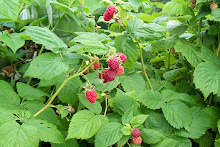
When I first started with Aromatherapy, I kept reading about the amazing healing and soothing powers of Calendula for skin. Unfortunately, there is no Calendula essential oil, just too hard to produce, I would think. A tiny little 20 gram tube of Calendula cream can set you back twenty or so dollars and wouldn't last all that long anyhow. So I learned to live without...until I got a garden. The plants themselves are very hardy and self-seeding. I can usually see them popping up around April, which is awfully early around here for anything to even start thinking of growing.
I found out Calendula flowers can easily be infused in oil. The oil absorbs the Calendula's healing properties and I can use it in remedies, lotions and creams. Most of my lotions and creams have about 20 - 50 per cent Calendula oil in them. I think it's great stuff.
Calendula flowers are easy to dry, just pick the whole flower and put 'em on newspaper until the petals practically fall off. They say the darker the petal, the more medicinal it is so I like the double, dark orange blooms. The only way I use them fresh is when my daughter needs some for her skin care. I steep some calendula petals in with some green tea and she uses it as a toner, it does seem to really help the problems of teenage skin. Sometimes for an extra boost, I'll add a couple of drops of lavender essential oil.
 I find infusing them is a piece of cake. Once the petals are completely dried, I put them in a jar and top it off with organic cold pressed olive oil. Fresh petals can be used instead of dried but then I'm mucking around with trying to syphon off the water from the fresh petals and if I don't get it all, there can be a mold issue, which I'd rather not deal with. Once the petals are in the oil, I put the jar in on a sunny window sill and or on top of a heat vent and shake once a day. And voila, two weeks later, I have a lovely golden oil that pretty much will keep until the next harvest. All I do is strain it, squeezing every drop of that lovely oil out of the petals and keep it in the fridge.
I find infusing them is a piece of cake. Once the petals are completely dried, I put them in a jar and top it off with organic cold pressed olive oil. Fresh petals can be used instead of dried but then I'm mucking around with trying to syphon off the water from the fresh petals and if I don't get it all, there can be a mold issue, which I'd rather not deal with. Once the petals are in the oil, I put the jar in on a sunny window sill and or on top of a heat vent and shake once a day. And voila, two weeks later, I have a lovely golden oil that pretty much will keep until the next harvest. All I do is strain it, squeezing every drop of that lovely oil out of the petals and keep it in the fridge.
disclaimer: This is how I use calendula for Aromatherapy, I am not recommending you do the same.
